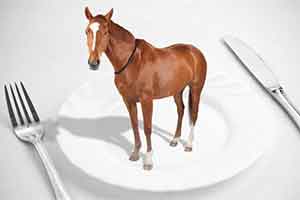Horsemeat, healthy for human consumption
The UPV/EHU’s Consolidated Research Group Lactiker is conducting a study into the nutritional quality of horsemeat sold at large and small outlets in the autonomous communities (regions) in the north of the Iberian Peninsula. Early results confirm that these products could be labelled as a source of omega-3-type fatty acids.
 The UPV/EHU’s Consolidated Research Group Lactiker, which studies the quality and safety of foods of animal origin, is working to evaluate the nutritional quality of horsemeat, in particular the quality of the fat fraction. The research focusses on the production of horsemeat, which is intended for human consumption, in the north of the Iberian Peninsula and is part of a broader research project that is tackling other aspects such as its sensory characteristics and acceptability among consumers as well as other important factors such as genomics, diet, authentication and traceability, plus ethical and socioeconomic aspects. According to the lecturer Noelia Aldai, “the aim is to promote the production of horsemeat in sustainable management conditions in order to obtain a high-quality food which is, at the same time, an affordable, healthy alternative for consumers, and also acceptable from the point of view of production conditions, taking animal welfare and environmental conservation into consideration”.
The UPV/EHU’s Consolidated Research Group Lactiker, which studies the quality and safety of foods of animal origin, is working to evaluate the nutritional quality of horsemeat, in particular the quality of the fat fraction. The research focusses on the production of horsemeat, which is intended for human consumption, in the north of the Iberian Peninsula and is part of a broader research project that is tackling other aspects such as its sensory characteristics and acceptability among consumers as well as other important factors such as genomics, diet, authentication and traceability, plus ethical and socioeconomic aspects. According to the lecturer Noelia Aldai, “the aim is to promote the production of horsemeat in sustainable management conditions in order to obtain a high-quality food which is, at the same time, an affordable, healthy alternative for consumers, and also acceptable from the point of view of production conditions, taking animal welfare and environmental conservation into consideration”.
One of the experimental parts of the research involved evaluating the nutritional quality of the horsemeat sold on both sides of the Cantabrian Mountains in the north of Spain. “The experimental design consisted of a sampling in two different seasons of the year (spring and winter) of horsemeat sold in specialised butchers’ and hypermarkets. The sampling was carried out in six autonomous communities (regions) in the north of the Iberian Peninsula: Basque Country, Navarre, Cantabria, Asturias, Galicia, and Castilla y León”, said Xabier Belaunzaran, one of the group’s researchers.
The results of the study highlight the fact that the fattiest samples were those of Navarre and Castilla y León, and the leanest were those of Asturias and Galicia, while those of the Basque Country and Cantabria had average fat values. “The variability observed between the regions pointed to clear differences in the management of the animals where breed, fodder and slaughter age appear to be the most important factors,” explained Belaunzaran. “On the whole, a higher omega-3-type polyunsaturated fatty acid content was observed in the samples gathered in winter, possibly due to the fact that the animals were raised on mountain pastures until the end of autumn.” What is more, “it is interesting to highlight the fact that 5% of the samples of horsemeat analysed achieved the minimum content of 300 mg of linoleic acid per 100 g of fresh meat required by Regulation 116/2010 of the European Commission to be able to label the product as a source of omega-3-type fatty acids”, added the researcher.
Before the experimental phase, the bibliography on horsemeat quality was reviewed in order to find out its current situation, the gaps in knowledge and the possible opportunities for research. In In the course of this review, data were gathered on production, marketing and availability of horsemeat per inhabitant across the world as well as the implications of the use of horses as a large-sized species, and approval by consumers. According to what could be seen, when compared with other species of ruminants, “these animals could offer advantages when it comes to using the mountain pastures, owing to their digestive physiology which is associated with greater efficiency in the transfer of polyunsaturated omega-3-type fatty acids from the pastures to the meat and a lower build-up of trans fatty acids, plus lower greenhouse gas emissions per unit of meat produced,” concluded Xabier Belaunzaran.
Source: University of the Basque Country
Full bibliographic information:
‘Horsemeat for human consumption – Current research and future opportunities’. Meat Science 108, 74-81 (2015).
‘An assessment of the fatty acid composition of horsemeat available at the retail level in northern Spain’. Meat Science 124, 39-47 (2017).

